Service GENESIS GV80 2021 Owner's Guide
[x] Cancel search | Manufacturer: GENESIS, Model Year: 2021, Model line: GV80, Model: GENESIS GV80 2021Pages: 632, PDF Size: 9.37 MB
Page 545 of 632
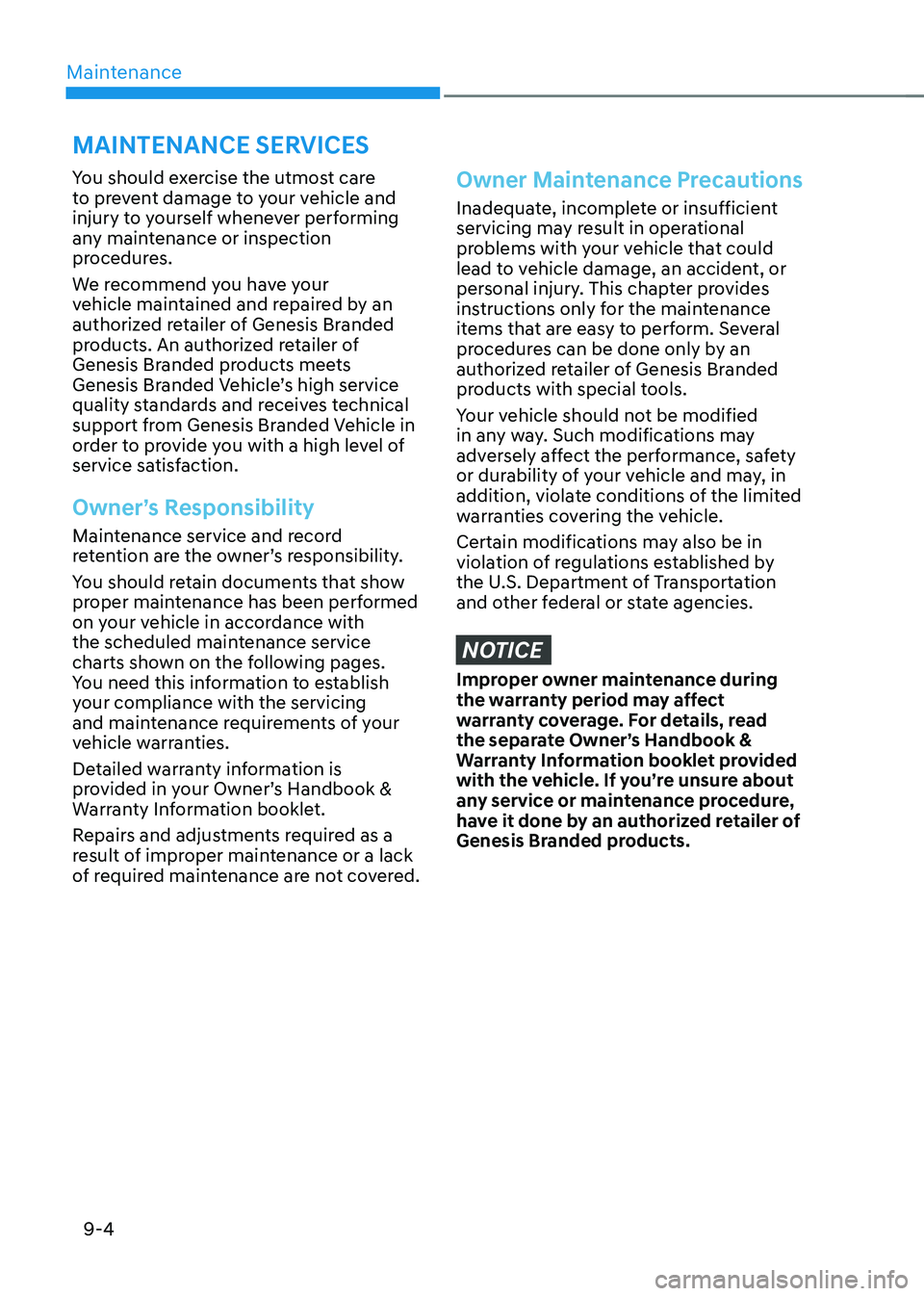
Maintenance
9-4
You should exercise the utmost care
to prevent damage to your vehicle and
injury to yourself whenever performing
any maintenance or inspection
procedures.
We recommend you have your
vehicle maintained and repaired by an
authorized retailer of Genesis Branded
products. An authorized retailer of
Genesis Branded products meets
Genesis Branded Vehicle’s high service
quality standards and receives technical
support from Genesis Branded Vehicle in
order to provide you with a high level of
service satisfaction.
Owner’s Responsibility
Maintenance service and record
retention are the owner’s responsibility.
You should retain documents that show
proper maintenance has been performed
on your vehicle in accordance with
the scheduled maintenance service
charts shown on the following pages.
You need this information to establish
your compliance with the servicing
and maintenance requirements of your
vehicle warranties.
Detailed warranty information is
provided in your Owner’s Handbook &
Warranty Information booklet.
Repairs and adjustments required as a
result of improper maintenance or a lack
of required maintenance are not covered.
Owner Maintenance Precautions
Inadequate, incomplete or insufficient
servicing may result in operational
problems with your vehicle that could
lead to vehicle damage, an accident, or
personal injury. This chapter provides
instructions only for the maintenance
items that are easy to perform. Several
procedures can be done only by an
authorized retailer of Genesis Branded
products with special tools.
Your vehicle should not be modified
in any way. Such modifications may
adversely affect the performance, safety
or durability of your vehicle and may, in
addition, violate conditions of the limited
warranties covering the vehicle.
Certain modifications may also be in
violation of regulations established by
the U.S. Department of Transportation
and other federal or state agencies.
NOTICE
Improper owner maintenance during
the warranty period may affect
warranty coverage. For details, read
the separate Owner’s Handbook &
Warranty Information booklet provided
with the vehicle. If you’re unsure about
any service or maintenance procedure,
have it done by an authorized retailer of
Genesis Branded products.
MAINTENANCE SERVICES
Page 548 of 632

09
9 -7
Follow Normal Maintenance Schedule if the vehicle is usually operated where none of
the following conditions apply. If any of the following conditions apply, you must follow
the Maintenance Under Severe Usage Conditions.
• Repeated driving short distance of less than 5 miles (8 km) in normal temperature or
less than 10 miles (16 km) in freezing temperature
• Extensive engine idling or low speed driving for long distances
• Driving on rough, dusty, muddy, unpaved, graveled or salt-spread roads
• Driving in areas using salt or other corrosive materials or in very cold weather
• Driving in heavy dust conditions
• Driving in heavy traffic area
• Driving on uphill, downhill, or mountain road repeatedly
• Towing a trailer or using a camper, or roof rack
• Driving as a patrol car, taxi, other commercial use of vehicle towing
• Driving over 106 mph (170 km/h)
• Frequently driving in stop-and-go condition
• Engine oil usage which is not recommended (mineral type, lower grade spec, etc.)
If your vehicle is operated under the above conditions, you should inspect, replace
or refill more frequently than the following Normal Maintenance Schedule. After the
periods or distance shown in the chart, continue to follow the prescribed maintenance
intervals.
NOTICE
After 10 years or 100,000 miles, we recommend to use severe maintenance
schedule.
SCHEDULED MAINTENANCE SERVICES
Page 551 of 632
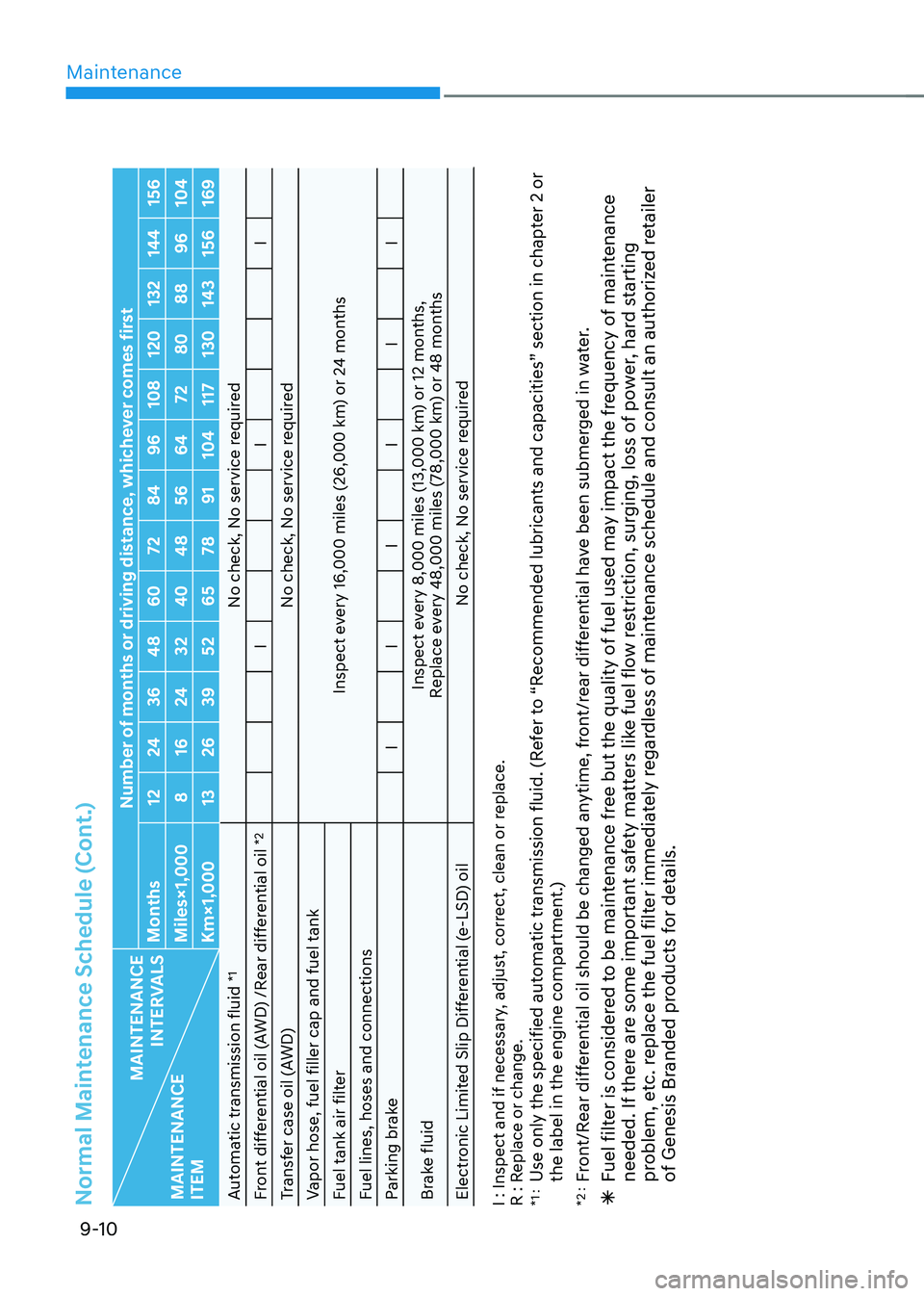
Maintenance
9-10
Normal Maintenance Schedule (Cont.)
MAINTENANCE
INTERVALS
MAINTENANCE
ITEM Number of months or driving distance, whichever comes first
Months 1224 3648 60 7284 96108 120 132144 156
Miles×1,000 816 24 3240 48 5664 7280 8896104
Km×1,000 1326 39 5265 78 91104 117130 143156169
Automatic transmission fluid
*1
No check, No service required
Front differential oil (AWD) /Rear differential oil
*2
I II
Transfer case oil (AWD) No check, No service required
Vapor hose, fuel filler cap and fuel tank Inspect every 16,000 miles (26,000 km) or 24 months
Fuel tank air filter
Fuel lines, hoses and connections
Parking brake IIIIII
Brake fluid Inspect every 8,000 miles (13,000 km) or 12 months,
Replace every 48,000 miles (78,000 km) or 48 months
Electronic Limited Slip Differential (e-LSD) oil No check, No service required
I : Inspect and if necessary, adjust, correct, clean or replace.
R : Replace or change.
*1 : Use only the specified automatic transmission fluid. (Refer to “Recommended lubricants and capacities” section in chapter 2 or
the label in the engine compartment.)
*2 : Front/Rear differential oil should be changed anytime, front/rear differential have been submerged in water. Ã Fuel filter is considered to be maintenance free but the quality of fuel used may impact the frequency of maintenance
needed. If there are some important safety matters like fuel flow restriction, surging, loss of power, hard starting
problem, etc. replace the fuel filter immediately regardless of maintenance schedule and consult an authorized retailer
of Genesis Branded products for details.
Page 552 of 632
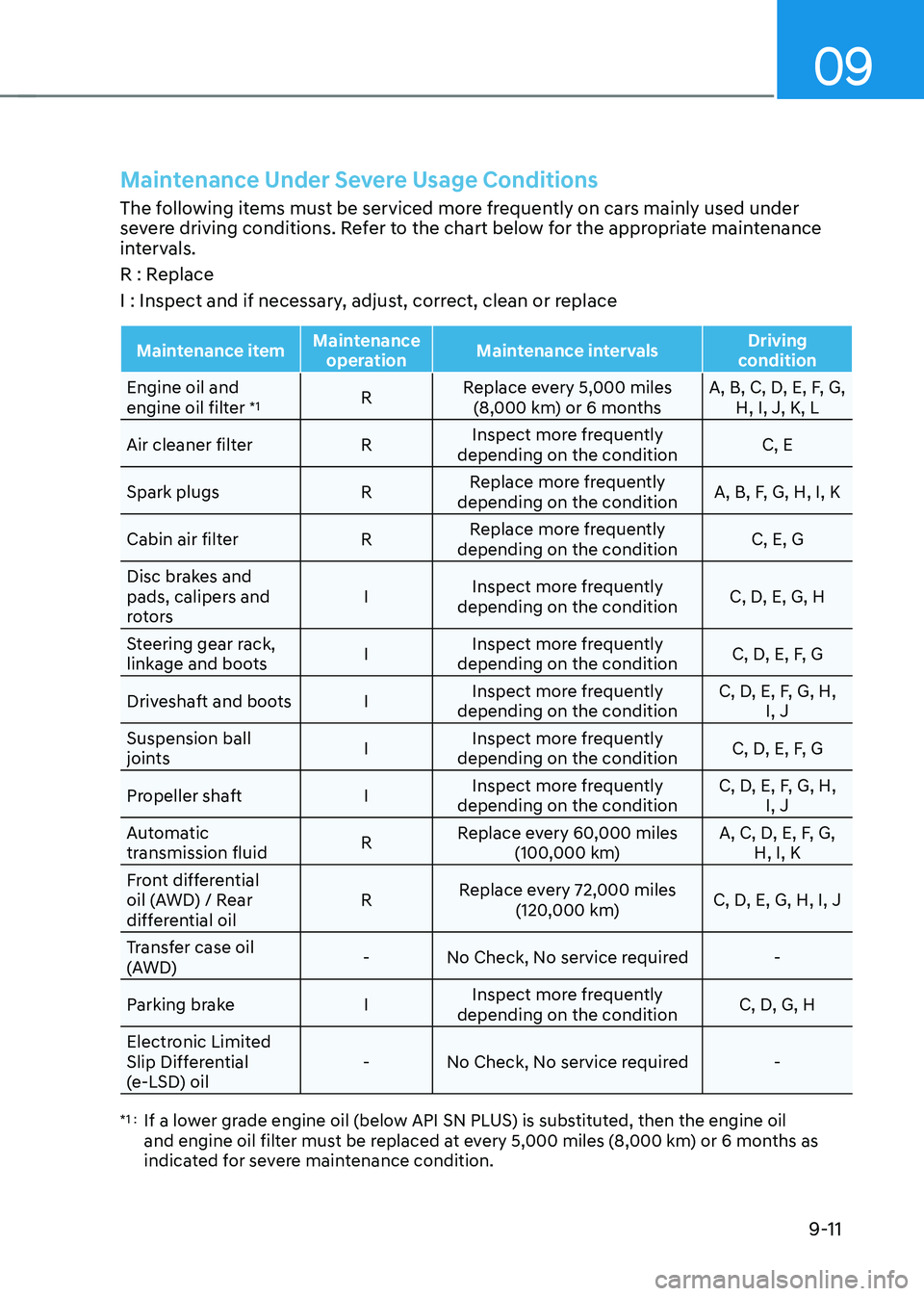
09
9-11
Maintenance Under Severe Usage Conditions
The following items must be serviced more frequently on cars mainly used under
severe driving conditions. Refer to the chart below for the appropriate maintenance
intervals.
R : Replace
I : Inspect and if necessary, adjust, correct, clean or replace
Maintenance itemMaintenance
operation Maintenance intervals Driving
condition
Engine oil and
engine oil filter
*1R Replace every 5,000 miles
(8,000 km) or 6 months A, B, C, D, E, F, G,
H, I, J, K, L
Air cleaner filter RInspect more frequently
depending on the condition C, E
Spark plugs RReplace more frequently
depending on the condition A, B, F, G, H, I, K
Cabin air filter RReplace more frequently
depending on the condition C, E, G
Disc brakes and
pads, calipers and
rotors I
Inspect more frequently
depending on the condition C, D, E, G, H
Steering gear rack,
linkage and boots IInspect more frequently
depending on the condition C, D, E, F, G
Driveshaft and boots IInspect more frequently
depending on the condition C, D, E, F, G, H,
I, J
Suspension ball
joints IInspect more frequently
depending on the condition C, D, E, F, G
Propeller shaft IInspect more frequently
depending on the condition C, D, E, F, G, H,
I, J
Automatic
transmission fluid RReplace every 60,000 miles
(100,000 km) A, C, D, E, F, G,
H, I, K
Front differential
oil (AWD) / Rear
differential oil R
Replace every 72,000 miles
(120,000 km) C, D, E, G, H, I, J
Transfer case oil
(AWD) -
No Check, No service required -
Parking brake IInspect more frequently
depending on the condition C, D, G, H
Electronic Limited
Slip Differential
(e-LSD) oil -
No Check, No service required -
*1 : If a lower grade engine oil (below API SN PLUS) is substituted, then the engine oil
and engine oil filter must be replaced at every 5,000 miles (8,000 km) or 6 months as
indicated for severe maintenance condition.
Page 570 of 632
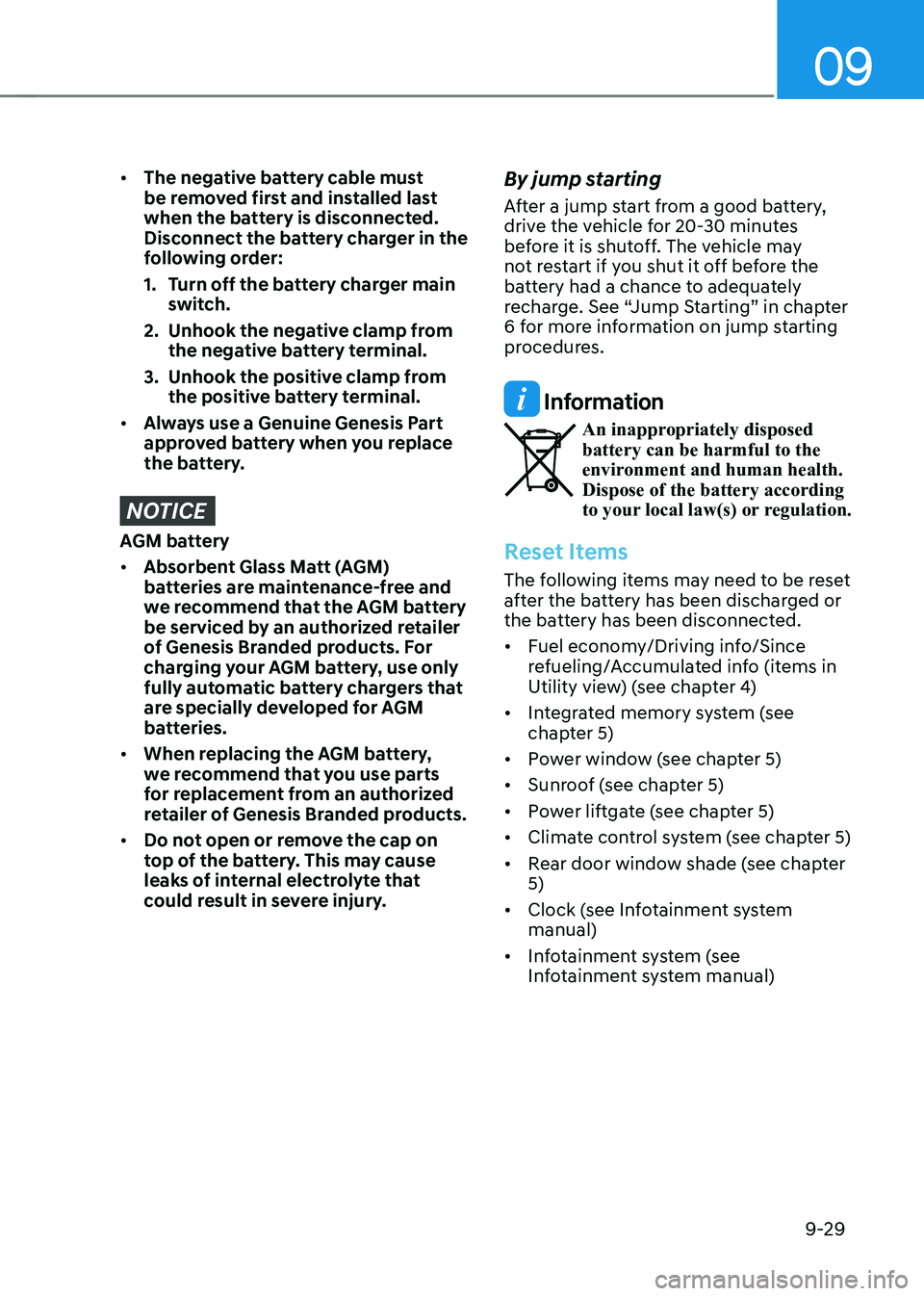
09
9-29
• The negative battery cable must
be removed first and installed last
when the battery is disconnected.
Disconnect the battery charger in the
following order:
1. Turn off the battery charger main
switch.
2. Unhook the negative clamp from
the negative battery terminal.
3. Unhook the positive clamp from
the positive battery terminal.
• Always use a Genuine Genesis Part
approved battery when you replace
the battery.
NOTICE
AGM battery
• Absorbent Glass Matt (AGM)
batteries are maintenance-free and
we recommend that the AGM battery
be serviced by an authorized retailer
of Genesis Branded products. For
charging your AGM battery, use only
fully automatic battery chargers that
are specially developed for AGM
batteries.
• When replacing the AGM battery,
we recommend that you use parts
for replacement from an authorized
retailer of Genesis Branded products.
• Do not open or remove the cap on
top of the battery. This may cause
leaks of internal electrolyte that
could result in severe injury.
By jump starting
After a jump start from a good battery,
drive the vehicle for 20-30 minutes
before it is shutoff. The vehicle may
not restart if you shut it off before the
battery had a chance to adequately
recharge. See “Jump Starting” in chapter
6 for more information on jump starting
procedures.
Information
An inappropriately disposed battery can be harmful to the
environment and human health.
Dispose of the battery according
to your local law(s) or regulation.
Reset Items
The following items may need to be reset
after the battery has been discharged or
the battery has been disconnected.
• Fuel economy/Driving info/Since
refueling/Accumulated info (items in
Utility view) (see chapter 4)
• Integrated memory system (see
chapter 5)
• Power window (see chapter 5)
• Sunroof (see chapter 5)
• Power liftgate (see chapter 5)
• Climate control system (see chapter 5)
• Rear door window shade (see chapter
5)
• Clock (see Infotainment system
manual)
• Infotainment system (see
Infotainment system manual)
Page 574 of 632
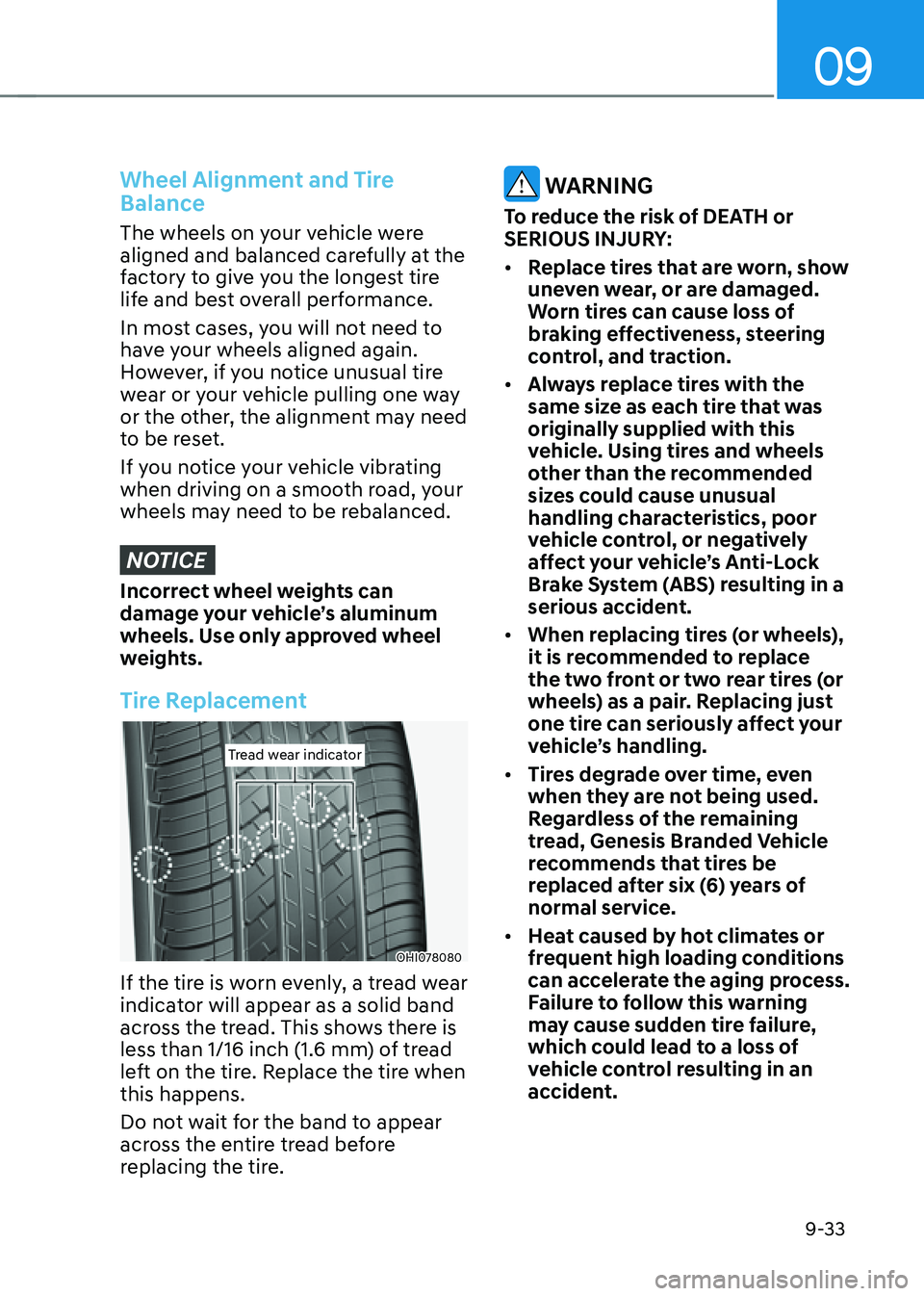
09
9-33
Wheel Alignment and Tire
Balance
The wheels on your vehicle were
aligned and balanced carefully at the
factory to give you the longest tire
life and best overall performance.
In most cases, you will not need to
have your wheels aligned again.
However, if you notice unusual tire
wear or your vehicle pulling one way
or the other, the alignment may need
to be reset.
If you notice your vehicle vibrating
when driving on a smooth road, your
wheels may need to be rebalanced.
NOTICE
Incorrect wheel weights can
damage your vehicle’s aluminum
wheels. Use only approved wheel
weights.
Tire Replacement
Tread wear indicatorTread wear indicator
OHI078080OHI078080
If the tire is worn evenly, a tread wear
indicator will appear as a solid band
across the tread. This shows there is
less than 1/16 inch (1.6 mm) of tread
left on the tire. Replace the tire when
this happens.
Do not wait for the band to appear
across the entire tread before
replacing the tire.
WARNING
To reduce the risk of DEATH or
SERIOUS INJURY:
• Replace tires that are worn, show
uneven wear, or are damaged.
Worn tires can cause loss of
braking effectiveness, steering
control, and traction.
• Always replace tires with the
same size as each tire that was
originally supplied with this
vehicle. Using tires and wheels
other than the recommended
sizes could cause unusual
handling characteristics, poor
vehicle control, or negatively
affect your vehicle’s Anti-Lock
Brake System (ABS) resulting in a
serious accident.
• When replacing tires (or wheels),
it is recommended to replace
the two front or two rear tires (or
wheels) as a pair. Replacing just
one tire can seriously affect your
vehicle’s handling.
• Tires degrade over time, even
when they are not being used.
Regardless of the remaining
tread, Genesis Branded Vehicle
recommends that tires be
replaced after six (6) years of
normal service.
• Heat caused by hot climates or
frequent high loading conditions
can accelerate the aging process.
Failure to follow this warning
may cause sudden tire failure,
which could lead to a loss of
vehicle control resulting in an
accident.
Page 578 of 632

09
9-37
6. Maximum permissible inflation
pressure
This number is the greatest amount
of air pressure that should be put in
the tire. Do not exceed the maximum
permissible inflation pressure. Refer
to the Tire and Loading Information
label for recommended inflation
pressure.
7. Maximum load rating
This number indicates the maximum
load in kilograms and pounds that
can be carried by the tire. When
replacing the tires on the vehicle,
always use a tire that has the same
load rating as the factory installed
tire.
8. Uniform tire quality grading
Quality grades can be found where
applicable on the tire sidewall
between tread shoulder and
maximum section width.
For example:
TREADWEAR 200
TRACTION AA
TEMPERATURE A Tread wear
The tread wear grade is a
comparative rating based on the
wear rate of the tire when tested
under controlled conditions on a
specified government test course.
For example, a tire graded 150 would
wear one-and-a-half times (1½) as
well on the government course as a
tire graded 100.
The relative performance of tires
depends upon the actual conditions
of their use, however, and may
depart significantly from the norm
due to variations in driving habits,
service practices and differences in
road characteristics and climate.
These grades are molded on the
sidewalls of passenger vehicle tires.
The tires available as standard or
optional equipment on your vehicle
may vary with respect to grade.
Traction - AA, A, B & C
The traction grades, from highest
to lowest, are AA, A, B and C. Those
grades represent the tire’s ability to
stop on wet pavement as measured
under controlled conditions on
specified government test surfaces
of asphalt and concrete. A tire
marked C may have poor traction
performance.
WARNING
The traction grade assigned to
this tire is based on straight ahead
braking traction tests, and does not
include acceleration, cornering,
hydroplaning, or peak traction
characteristics.
Page 628 of 632
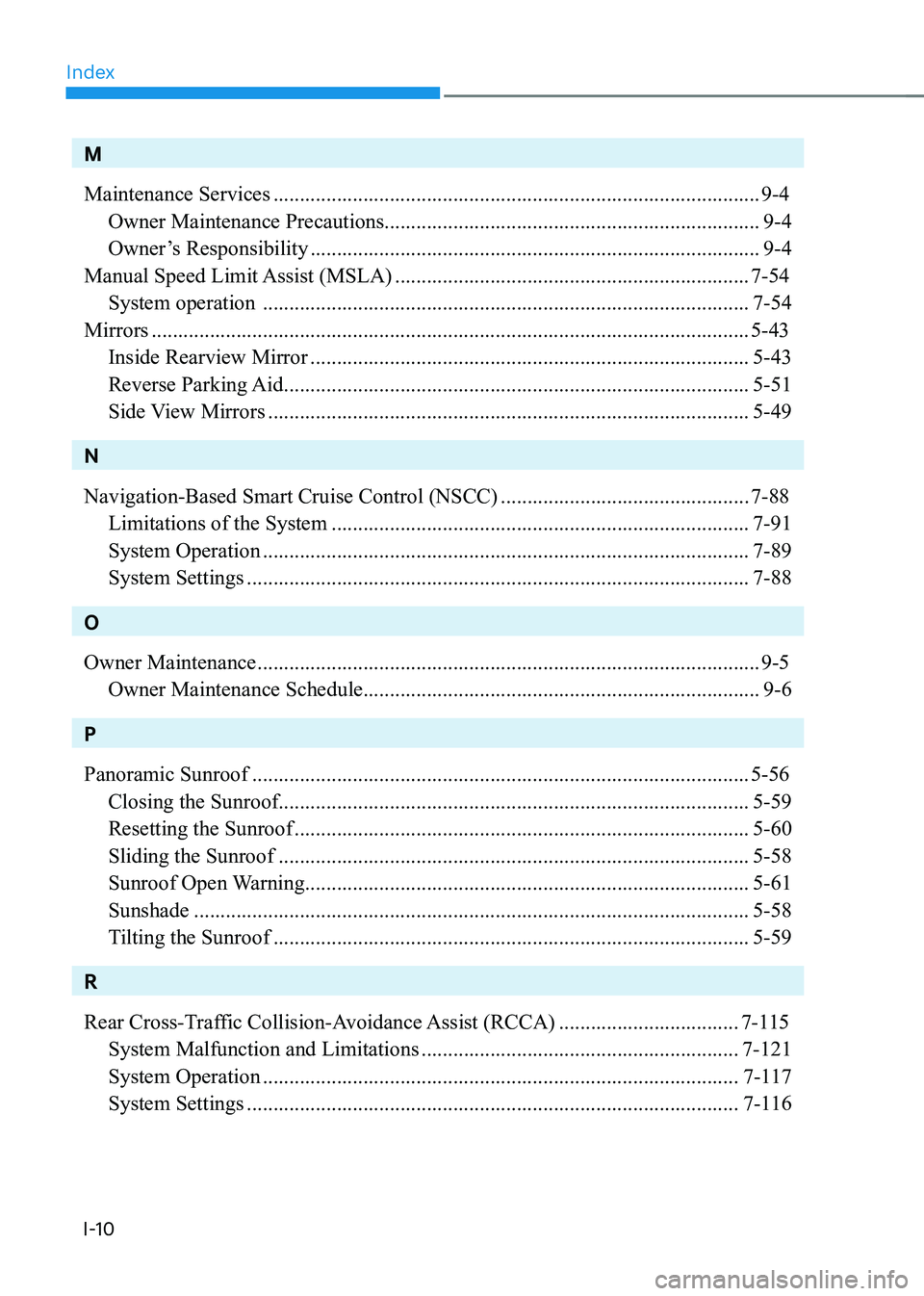
Index
I-10
M
Maintenance Services
........................................................................\
....................9-4
Owner Maintenance Precautions ....................................................................... 9-4
Owner’s Responsibility
........................................................................\
.............9-4
Manual Speed Limit Assist (MSLA)
...................................................................7-54
System operation
........................................................................\
....................7-54
Mirrors
........................................................................\
.........................................5-43
Inside Rearview Mirror
........................................................................\
...........5-43
Reverse Parking Aid
........................................................................\
................5-51
Side View Mirrors
........................................................................\
...................5-49
N
Navigation-Based Smart Cruise Control (NSCC)
...............................................7-88
Limitations of the System
........................................................................\
.......7-91
System Operation
........................................................................\
....................7-89
System Settings
........................................................................\
.......................7-88
O
Owner Maintenance
........................................................................\
.......................9-5
Owner Maintenance Schedule ........................................................................\
... 9-6
P
Panoramic Sunroof
........................................................................\
......................5-56
Closing the Sunroof ........................................................................\
................. 5-59
Resetting the Sunroof
........................................................................\
..............5-60
Sliding the Sunroof
........................................................................\
.................5-58
Sunroof Open Warning
........................................................................\
............5-61
Sunshade
........................................................................\
.................................5-58
Tilting the Sunroof
........................................................................\
..................5-59
R
Rear Cross-Traffic Collision-Avoidance Assist (RCCA)
..................................7-115
System Malfunction and Limitations
............................................................7-121
System Operation
........................................................................\
..................7-117
System Settings
........................................................................\
.....................7-116
Page 629 of 632
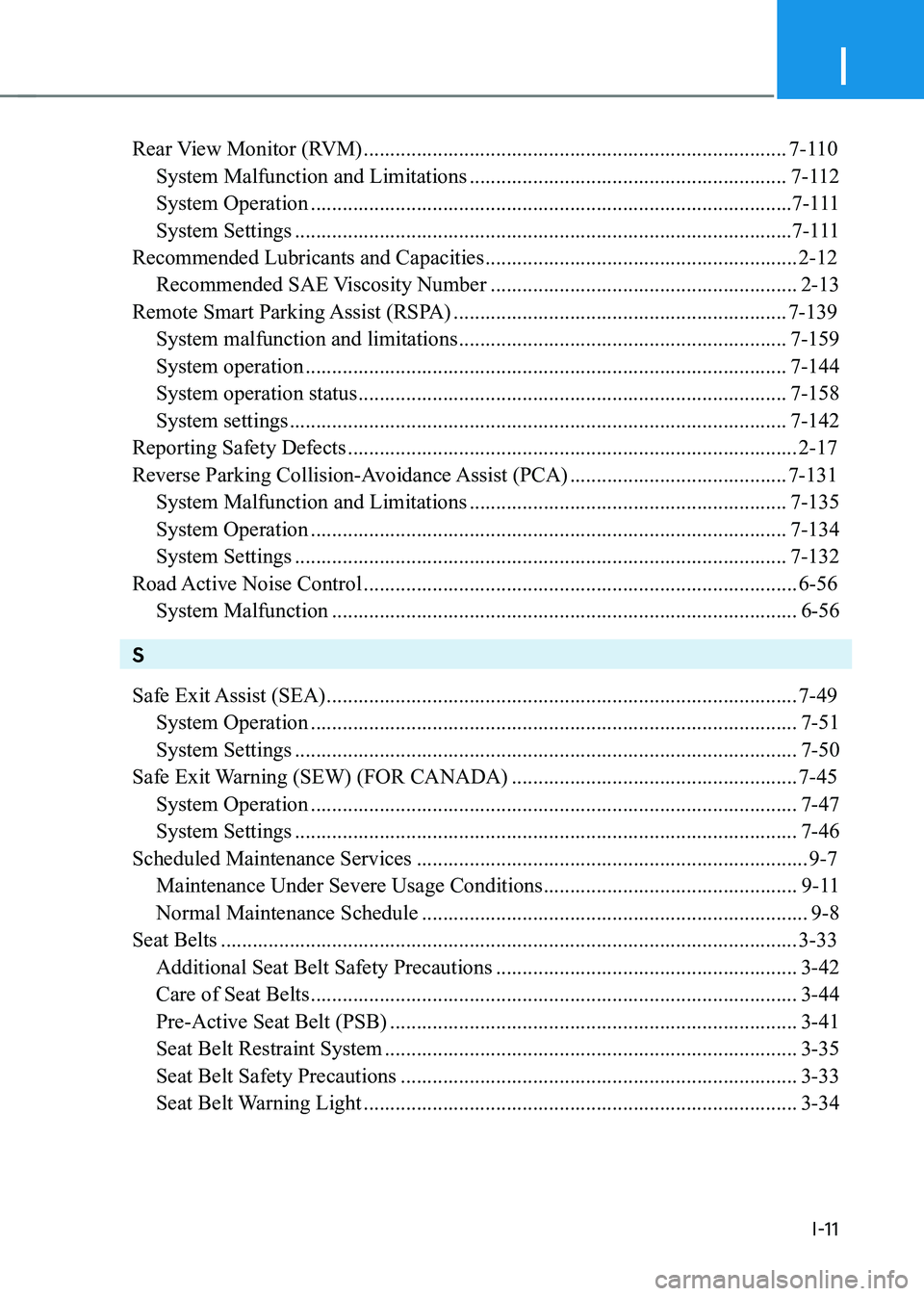
I
I-11
Rear View Monitor (RVM) ........................................................................\
........7-110
System Malfunction and Limitations
............................................................7-112
System Operation
........................................................................\
...................7-111
System Settings
........................................................................\
......................7-111
Recommended Lubricants and Capacities
...........................................................2-12
Recommended SAE Viscosity Number
..........................................................2-13
Remote Smart Parking Assist (RSPA)
...............................................................7-139
System malfunction and limitations
..............................................................7-159
System operation
........................................................................\
...................7-144
System operation status
........................................................................\
.........7-158
System settings
........................................................................\
......................7-142
Reporting Safety Defects
........................................................................\
.............2-17
Reverse Parking Collision-Avoidance Assist (PCA)
.........................................7-131
System Malfunction and Limitations
............................................................7-135
System Operation
........................................................................\
..................7-134
System Settings
........................................................................\
.....................7-132
Road Active Noise Control
........................................................................\
..........6-56
System Malfunction
........................................................................\
................6-56
S
Safe Exit Assist (SEA)
........................................................................\
.................7-49
System Operation
........................................................................\
....................7-51
System Settings
........................................................................\
.......................7-50
Safe Exit Warning (SEW) (FOR CANADA)
......................................................7-45
System Operation
........................................................................\
....................7-47
System Settings
........................................................................\
.......................7-46
Scheduled Maintenance Services
........................................................................\
..9-7
Maintenance Under Severe Usage Conditions
................................................9-11
Normal Maintenance Schedule
........................................................................\
.9-8
Seat Belts
........................................................................\
.....................................3-33
Additional Seat Belt Safety Precautions
.........................................................3-42
Care of Seat Belts
........................................................................\
....................3-44
Pre-Active Seat Belt (PSB)
........................................................................\
.....3-41
Seat Belt Restraint System
........................................................................\
......3-35
Seat Belt Safety Precautions
........................................................................\
...3-33
Seat Belt Warning Light
........................................................................\
..........3-34
Page 631 of 632
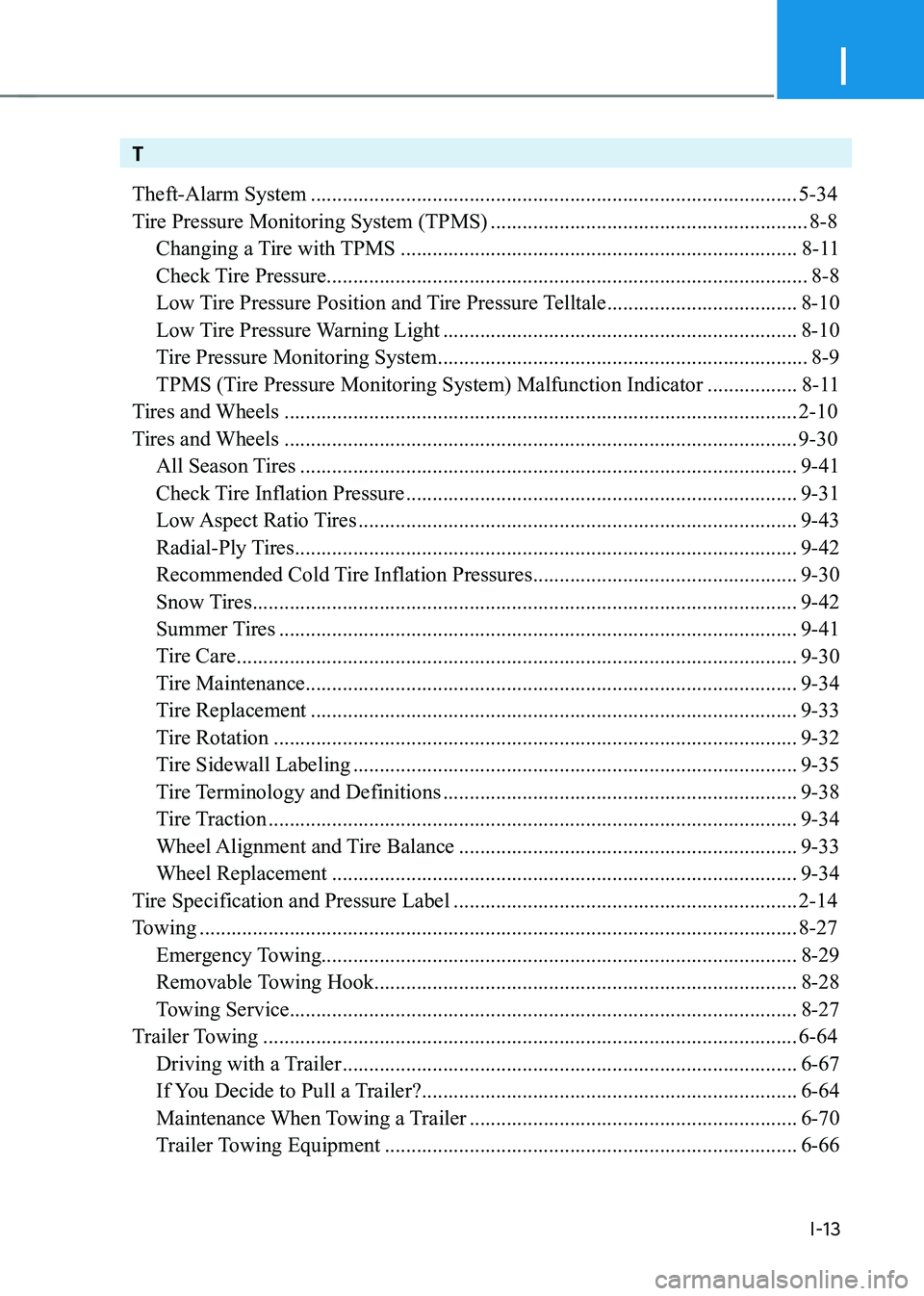
I
I-13
T
Theft-Alarm System
........................................................................\
....................5-34
Tire Pressure Monitoring System (TPMS)
............................................................8-8
Changing a Tire with TPMS
........................................................................\
...8-11
Check Tire Pressure ........................................................................\
................... 8-8
Low Tire Pressure Position and Tire Pressure Telltale
....................................8-10
Low Tire Pressure Warning Light
...................................................................8-10
Tire Pressure Monitoring System
......................................................................8-9
TPMS (Tire Pressure Monitoring System) Malfunction Indicator
.................8-11
Tires and Wheels
........................................................................\
.........................2-10
Tires and Wheels
........................................................................\
.........................9-30
All Season Tires
........................................................................\
......................9-41
Check Tire Inflation Pressure
........................................................................\
..9-31
Low Aspect Ratio Tires
........................................................................\
...........9-43
Radial-Ply Tires
........................................................................\
.......................9-42
Recommended Cold Tire Inflation Pressures
..................................................9-30
Snow Tires
........................................................................\
...............................9-42
Summer Tires
........................................................................\
..........................9-41
Tire Care
........................................................................\
..................................9-30
Tire Maintenance
........................................................................\
.....................9-34
Tire Replacement
........................................................................\
....................9-33
Tire Rotation
........................................................................\
...........................9-32
Tire Sidewall Labeling
........................................................................\
............9-35
Tire Terminology and Definitions
...................................................................9-38
Tire Traction
........................................................................\
............................9-34
Wheel Alignment and Tire Balance
................................................................9-33
Wheel Replacement
........................................................................\
................9-34
Tire Specification and Pressure Label
.................................................................2-14
Towing
........................................................................\
.........................................8-27
Emergency Towing ........................................................................\
.................. 8-29
Removable Towing Hook........................................................................\
........ 8-28
Towing Service
........................................................................\
........................8-27
Trailer Towing
........................................................................\
.............................6-64
Driving with a Trailer
........................................................................\
..............6-67
If You Decide to Pull a Trailer?
.......................................................................6-64
Maintenance When Towing a Trailer
..............................................................6-70
Trailer Towing Equipment
........................................................................\
......6-66